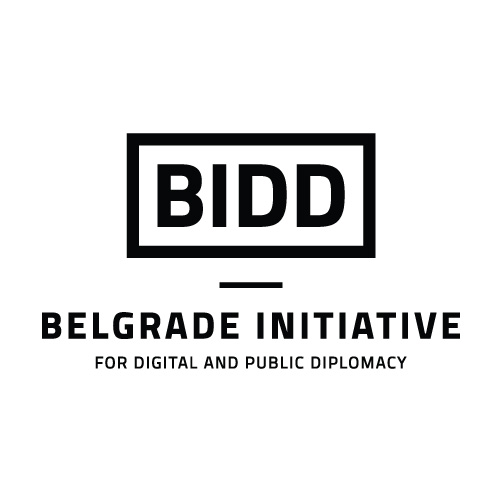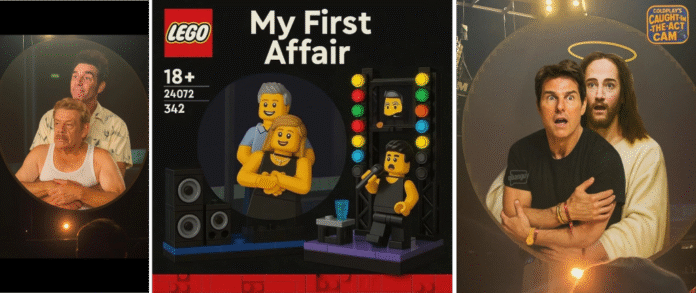On July 17, 2025, a kiss cam at a Coldplay concert captured Astronomer CEO Andy Byron and HR chief Kristin Cabot embracing, prompting viral speculation of an affair. The lead singer’s on-stage comment, “Either they’re having an affair or they’re just very shy”, as well as the couple’s obvious alarm at being caught on camera, generated a viral video sensation garnering 90 million views on TikTok. The virality of the moment grew greater still when Astronomer announced they were launching a formal investigation which resulted in the resignation of both individuals.
As is often the case with viral moments, the kiss cam video yielded a flurry of memes each depicting different couples being caught at a similar moment. Yet past viral moments, there was another response to the Coldplay scandal in the form of hundreds of AI generated visuals. In many instances, these visuals recreated the scene while using pop culture references.
One of the first AI visuals to gain popularity online recreated the scenes using a Lego playset titled “My First Affair”. Soon, other similar AI visuals gained millions of shares including an AI image depicting Seinfeld characters on the kiss cam, an AI image depicting characters from Wicked, Marvel superheroes caught in a similar compromising position and even actor Tom Cruise caught hugging Jesus Christ on a kiss cam.
These images are a new form of viral content that can no longer be referred to simply as memes. True, memes are units of media that are used online in reference to a real-world event. True, memes spread online and are constantly shaped and reshaped by internet users. True, mems rest on humor and include the mixing and remixing of content in new ways. True, memes often emerge from news items including tabloid scandals. But some of the most popular and beloved memes rest on the use and reuse of a viral image with users adding new text and new layers of meanings.

Yet that is not the case with the new genre of AI generated images. These images constitute a new language through which internet users comment on daily events, be it tabloid scandals, political affairs or even international crises. These images constitute a language because they rely on pop culture references. In a globalized media ecology popular culture becomes a global reservoir of signs and symbols; symbols that are familiar to individuals in the UK, Germany, Japan, Korea and China. Although not all culture is global, and although different countries have local pop cultures, the globalization of media entertainment, the creation of entertainment and media franchises that are marketed globally like Marvel films, the emergence of a global social media ecosystem and the global proliferation of streaming services such as Netflix, Prime and Disney + all result in the creation of a shared global language in which a set of signs can be deciphered by people all around the globe.
And crucially, these signs or symbols have similar meanings across the world.
That is why Ukrainian supporters have leveraged pop culture when generating images related to the 2022 Russia-Ukraine War. An image of Ukraine’s President, Volodymyr Zelenskyy, dressed in superhero outfit and carrying a large shield generates a similar meaning in the minds of social media users across the world- one of Captain Ukraine modeled after the pop culture hero Captain America.
And yet this new language does not consist solely of pop culture references, but it rests on visuals generated by AI, and may thus be called “PopAI”. Users who view the visual without knowing that it was generated by AI will be unable to grasp its full meaning. Such users are not native speakers “PopAI” subsequently its signs and symbols remain somewhat elusive. Native speakers of “PopAI” are able to fuse both parts of the symbol, the cultural and the technological, to arrive at a unified meaning.
For example, an internet user unfamiliar with AI would find it hard to grasp the full meaning of the Lego image above. He or she may understand that the Lego image references the Coldplay scandal, and that it is a humorous image that does not actually depict a real-life Lego playset. But they would not grasp the additional layer of meaning which is that the Lego image was co-created by individuals and machines, that it was generated using prompts or through conversations between individuals and machines, that this is an entirely new image that did not exist before AI and that could not exist without AI, and that the image is both real and unreal.
This is a crucial element of the “PopAI” language because its symbols are real and unreal at the same time. The Lego image is real in the sense that it now exists in the world and can be seen by many. Moreover, like all AI images it seems real, so real that it might fool innocent onlookers or non-native speaker of “PopAI”. And yet the image is not real- there is no such Lego play set, there is no such Lego box, there is no such product. The image itself is unreal in the sense that it is a collage, an algorithmic amalgamation of thousands of pre-existing real images of Lego boxes on which the AI was trained.
As such, “PopAI” is a language that by nature manipulates our notion of the real. A “PopAI” symbols relate to the real (world) by referencing the real (culture) and building on the real (images digested by AIs) to create an unreal visual. And it is the unreal nature of the visual that is crucial to the symbol’s meaning as “PopAI” speakers recognize that the Wicked visual above is real and unreal, that it takes real actors and real characters and manipulates them until and unreal artefact is formed.
And its meaning? In the case of both the Lego and the Wicked image the visuals’ meaning relates to the hypocrisy of late stage capitalism in which infidelity is scorned and punishable but also used to create viral content that is shared and consumed globally by internet users while generating billions in revenue for social medic oligarchs and digital companies. If translated to the physical world, this hypocrisy may have well promoted Lego to seize the moment and release a play set called “My First Affair” or the producers of Wicked to release a real image the movie’s actors to generate more sales. In this way the unreal comments on the real, or the AI Lego box says something about the real world.
“PopAI” speakers are those who will be able to navigate the emerging world of AI visuals in which real people are constantly depicted in unreal setting or scenarios. “PopAI” speakers will be able to discern real images of world leaders partaking in a fashion show and an AI video supposedly depicting world leaders partaking in a fashion show. In a way, the emergence of the “PopAI” language might suggest that the coercive nature of AI visuals is not infinite and that through the use of generative AI digital users are beginning to recognize how human-machine interactions manipulate the real and generate seemingly real visuals that are entirely unreal.













